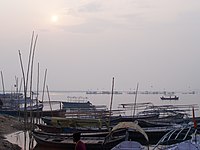Triveni Sangam at Allahabad

The Triveni Sangam, the intersection of Yamuna River andGanges River
In Hindu tradition Triveni Sangam is the "confluence" of three rivers. Sangama is theSanskrit word for confluence. The point of confluence is a sacred place for Hindus. A bath here is said to flush away all of one's sins and free one from the cycle of rebirth.
Triveni Sangam at Allahabad
One such Triveni Sangam, in Prayag (Allahabad) has two physical rivers — Gangesand Yamuna — and the invisible Saraswati River.[1] The site is in Prayag, India. A place of religious importance and the site for historicKumbh Mela held every 12 years, over the years it has also been the site of immersion of ashes of several national leaders, includingMahatma Gandhi in 1948.[2]
The rivers maintain their identity and are visibly different as they merge. While the Yamuna is deep, calm, and greenish in colour, the Ganga is shallow, forceful, and clear. The Saraswati remains hidden, but the faithful believe that she makes her presence felt underwater. During the monsoon, when the rivers are in full flow, the confluence is seen clearly due to the force of the waterThe same force makes having a dip at the confluence difficult. While the Ganges is only 4 feet deep, the Yamuna is 40 feet deep near the point of their nexus. The river Yamuna merges into the Ganges at this point and the Ganges continues on until it meets the sea at the Bay of Bengal.
At the confluence of these two great Indian rivers, where the invisible Saraswati conjoins them, Hindu pilgrims take boats to bathe from platforms erected at the confluence. This, together with the migratory birds give a picturesque look to the river during the Kumbha Mela, in January. It is believed that all the gods come in human form to take a dip at the sangam and expiate their sins.
Notable people
This was the river where one of the former prime ministers of India, Indira Gandhi used to come for a holy dip. On the bank of the Ganges at Daraganj, just before the confluence of the Ganga and Yamuna, the well-known statistician Ravindra Khattreespent his early years when he attended Ewing Christian College, on the bank of Yamuna few miles before the confluence. The famous writer Suryakant Tripathi 'Nirala' spent his whole life at the same place (Daraganj). On the other bank of the river Ganges at Arail is the Maharshi Institute of Management, named for Maharshi Mahesh Yogi who was a student at the University of Allahabad. TheHarish Chandra Research Institute, named after the famous mathematician Harish Chandra from Allahabad, is on the same side, in the town of Jhusi.
Religious significance
The Triveni Sangam is believed to be the place where drops of nectar fell from the pitcher, from the hands of the Gods. It is believed that a bath in the sangam will wash away all one's sins and will clear the way to heaven. Devout Hindus from all over India come to this sacred pilgrimage point to offer prayers and take a dip in the holy waters. The sacred Kumbh Mela is held every 12 years on the banks of Ganga, Yamuna and Sarsvati at Sangam.
According to Hindu tradition, the Prakrista Yajna was performed here by Lord Brahma. That is why Allahabad was known as Prayagin ancient times. Allahabad (Prayag) is also called Tirtha-Raja (Prayag Raj), king of all holy places. It is said that Lord Rama visited Prayag Raj/Allahabad when he was in exile.
Other Triveni Sangams
Bhagamandala
Main article: Bhagamandala
Bhagamandala is a pilgrimage place inKodagu district of Karnataka. It is situated on the river Kaveri in its upstream stretches. At this place, the Kaveri is joined by two tributaries, the Kannike and the mythical Sujyoti river. It is considered sacred as a river confluence (kudala or triveni sangama, inKannada and Sanskrit respectively).
Erode
Main article: Kooduthurai
The Triveni Sangam in Erode is a confluence of 3 rivers, the Cauvery, Bhavani and Amudha. Of these three, the river Amudha is invisible and is said to flow underground and join the other two rivers from below. It is also called as Kooduthurai, where the famousSangameswarar Temple is located.
Tirumakudalu Narasipura
Main article: Tirumakudalu Narasipura
Tirumakudalu Narasipura, commonly known as T. Narasipura,[3] is a panchayat town inMysore district in the Indian state ofKarnataka. The first name refers to the land at the confluence, (trimakuta in Sanskrit) at the confluence of the Kaveri, Kabini and Spatika Sarovara (a mythical lake or spring, also named Gupta Gamini). This is the place in South India where local Kumbhamela is held every three years. [4]
Moovattupuzha
Main article: Moovattupuzha
Kaliyar,Thodupuzha river and Kothamangalam Puzha are joined and becomes Moovattupuzha river in Kerala.
Indrakund
Main article: IndraKund, Nashik
At Indrakunda Nashik, 2 Mythical rivers Aruna & Varuna meet Godavari making it a Triveni Sangam.

No comments:
Post a Comment